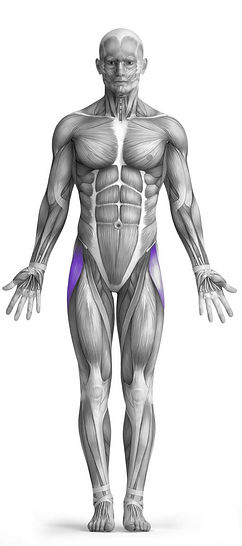Hip Flexor Lacrosse Ball 101 Video Tutorial
0

Exercise Synopsis
Target Muscle Group
Hip Flexors
Secondary Targets
None
Execution
Isolation
Force Type
Compression
Required Equipment
Lacrosse Ball
Fitness Level
Intermediate
Variations
None
Alternatives
None
Timer
Hour
Minute
Second
Stopwatch
00:00:00:00
Overview
The "Hip Flexor Lacrosse Ball" exercise is designed to target the hip flexors using a lacrosse ball for self-myofascial release. By applying pressure to the hip flexor area, this exercise helps alleviate tension, improve flexibility, and enhance mobility in the hip region. It is particularly beneficial for individuals who experience tightness in their hip flexors due to prolonged sitting or intense physical activity. The lacrosse ball provides a firm, focused pressure that helps release muscle knots and reduce discomfort in the hip flexors, making it an effective recovery tool for better movement and posture. No additional equipment is required other than the lacrosse ball.
How to Perform
Start by locating your belly button and the front part of your hip bone (ASIS). Visualize a diagonal line connecting these two points.
Position the lacrosse ball in the middle of this line, ensuring it's centered between the belly button and hip bone.
Lie down on your stomach with the lacrosse ball placed over the target area, ensuring it's directly on the hip flexors.
Rest your head in your hands for support, and gradually apply your body weight to the ball.
Gently move your body to roll the ball over the hip flexor area, applying light to moderate pressure. Focus on relaxing and breathing while rolling for 20-30 seconds.
After completing the first side, switch to the other side and repeat the process.
★ Bonus: For exercises that involve external weights (such as dumbbells, barbells, or machines), the One Rep Max (1RM) calculator can help you estimate your maximum lifting capacity. Use it to track your strength progress and adjust your training for optimal results.
Tips
The key thing to remember when performing any soft tissue work is to keep breathing. Avoid holding your breath, as this can cause tension rather than help you release it.
If you come across a tender or tight spot, pause for 5-6 seconds. Focus on slow, deep breaths to help relax your muscles and alleviate the discomfort.
While Self-Myofascial Release (SMR) can be uncomfortable, don’t let that discourage you. The sensation comes from physiological or neurological factors, and the more consistently you do it, the better the feeling should become—assuming there are no serious underlying issues.
Make sure to maintain a strong, active posture with your upper body. Avoid slumping or collapsing into the shoulder capsule while performing the exercise.
If you experience any burning, numbness, or tingling sensations, continue moving past that area. These feelings are likely from nerve sensitivity, and staying on that spot for too long could cause further discomfort or harm.
How Not to Perform
Avoid Holding Your Breath: Do not hold your breath while performing the exercise. This can increase tension in your body, making it harder to relax and target the hip flexors effectively. Focus on steady, controlled breathing to help release muscle tightness.
Don’t Apply Too Much Pressure Too Quickly: Be careful not to put excessive pressure on the lacrosse ball right from the start. Gradually ease into the exercise by applying moderate pressure and allow your body to adjust. Overloading the muscle may cause unnecessary pain or discomfort.
Avoid Slouching or Collapsing: Do not let your upper body slouch or collapse while lying on the ball. Keeping an active, engaged upper body will ensure that you’re not wasting energy or affecting your posture. Keep your core slightly engaged and maintain a neutral spine throughout.
Don’t Rush Through the Roll: Do not move too quickly while rolling the lacrosse ball over the hip flexors. Take your time and focus on slow, controlled movements. Rapid rolling will not allow you to target the muscle effectively and can cause unnecessary tension.
Don’t Focus on Uncomfortable Spots for Too Long: If you find a particularly tender spot, don’t linger there for too long. While it's okay to pause for a few seconds, staying on a single spot for an extended period can cause discomfort and may even lead to injury. Keep moving the ball gradually to avoid overstressing one area.
Avoid Shifting Your Weight Improperly: Be cautious not to shift your weight awkwardly onto one side or roll in an uncontrolled manner. This can strain other areas of your body or take the focus off the hip flexors. Keep your movements deliberate and steady to ensure you’re targeting the right area.
Don’t Ignore Discomfort or Pain Signals: While the exercise may feel uncomfortable, sharp or shooting pain is a sign that you’re overdoing it. If you experience significant pain, stop and reassess. Continuing despite pain can lead to injury. Stick to a level of discomfort that is tolerable and manageable.
Avoid Incorrect Ball Placement: Ensure the lacrosse ball is positioned correctly on the hip flexors. If the ball is placed too high, too low, or on a different muscle group, you won’t effectively target the hip flexors. Double-check the placement and adjust as necessary for the best results.
Variations
Variations of fitness exercises refer to different ways of performing a specific exercise or movement to target various muscle groups, intensities, or goals. These variations aim to challenge the body differently, prevent plateaus, and cater to individuals with varying fitness levels.
Alternatives
Alternative exercises in fitness refer to different movements or activities that target similar muscle groups or serve the same training purpose as the primary exercise. These alternative exercises can be used as substitutes when the original exercise is unavailable or challenging to perform due to various reasons such as equipment limitations, injuries, or personal preferences.



